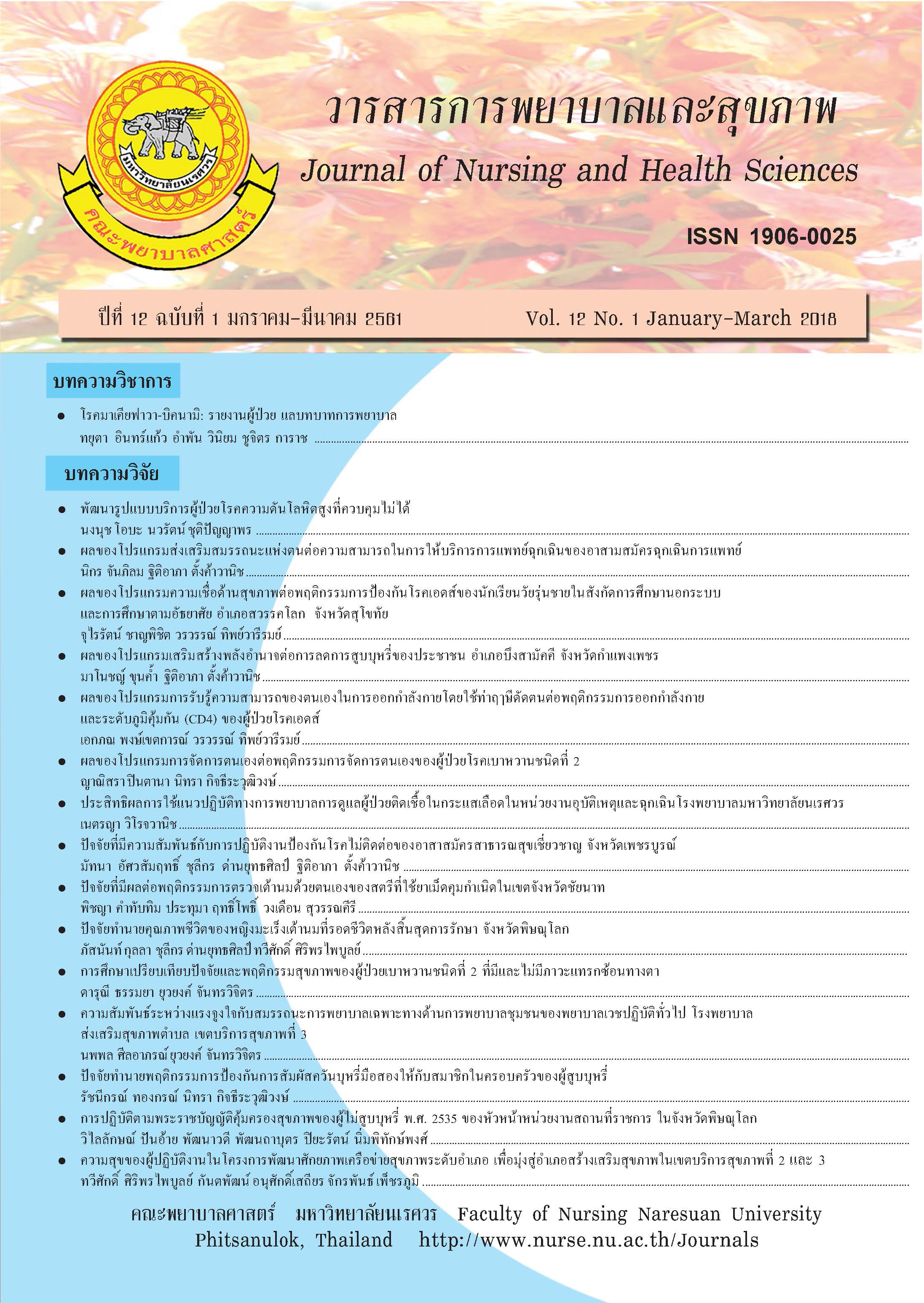ประสิทธิผลการใช้แนวปฏิบัติทางการพยาบาลการดูแลผู้ป่วยติดเชื้อในกระแสเลือด ในหน่วยงานอุบัติเหตุและฉุกเฉิน โรงพยาบาลมหาวิทยาลัยนเรศวร
Main Article Content
บทคัดย่อ
ภาวะติดเชื้อในกระแสเลือดส่งผลรุนแรงต่อผู้ป่วย ภาวะนี้เพิ่มอัตราการเสียชีวิต จำนวนวันนอน และ ค่าใช้จ่าย ในผู้ป่วยโรงพยาบาลมหาวิทยาลัยนเรศวร การวิจัยครั้งนี้เป็นการวิจัยและพัฒนา วัตถุประสงค์ เพื่อพัฒนาแนวทางปฏิบัติทางการพยาบาลในการดูแลผู้ป่วยติดเชื้อในกระแสเลือด และศึกษาประสิทธิผล ของแนวทางปฏิบัติทางการพยาบาล ในหน่วยงานอุบัติเหตุและฉุกเฉิน โรงพยาบาลมหาวิทยาลัยนเรศวร กลุ่มตัวอย่างแบ่งเป็น 2 กลุ่ม คือ กลุ่มก่อนและกลุ่มหลังการใช้แนวทางปฏิบัติทางการพยาบาล กลุ่มละ 40 ราย เครื่องมือมี 3 ส่วน คือ 1) แนวทางปฏิบัติทางการพยาบาลในการดูแลผู้ป่วยติดเชื้อในกระแสเลือด 2) แบบบันทึกผลลัพธ์การดูแลผู้ป่วยติดเชื้อในกระแสเลือด และ3) แบบประเมินความเหมาะสม มีค่า IOC ระหว่าง 0.6-1.00 แบบประเมินความเหมาะสมค่าความเที่ยง เท่ากับ 0.78 วิเคราะห์ข้อมูลโดยแจกแจง ความถี่ จำนวน ร้อยละ ค่าเฉลี่ย Chi-square และ Independent t- test ผลการศึกษาพบว่า 1. แนวทางการปฏิบัติทางการพยาบาลในการดูแลผู้ป่วยติดเชื้อในกระแสเลือดมี 3 ระยะคือ 1) การคัดกรอง ผู้ป่วยติดเชื้อในกระแสเลือด 2) การช่วยเหลือในระยะแรกและ 3) การดูแลอย่างต่อเนื่อง 2. ค่าสัดส่วนของการดักจับอาการของ Severe Sepsis ได้ทันเวลาและ และค่าสัดส่วนการพ้นภาวะช็อก ภายใน 6 ชั่วโมง เพิ่มขึ้นอย่างมีนัยสำคัญทางสถิติ (p < .05) อัตราการเสียชีวิต และค่าใช้จ่ายในการรักษา ตลอดการ Admit ลดลง อย่างมีนัยสำคัญทางสถิติ (p < .05) สรุปได้ว่าแนวทางการปฏิบัติทางการพยาบาล มีประสิทธิผลต่อผู้ป่วยติดเชื้อในกระแสเลือด ในโรงพยาบาล มหาวิทยาลัยนเรศวร
Article Details
เอกสารอ้างอิง
เสียชีวิตของผู้ป่วยที่มีภาวะsepsis ในโรงพยาบาล
อุตรดิตถ์. วารสารวัณโรค โรคทรวงอก และ
บำบัดวิกฤต, 29, 135-144.
งานพัฒนาคุณภาพโรงพยาบาลมหาวิทยาลัยนเรศวร.
(2557). Hospital Profile 2557 (หน้า 30-31).
พิษณุโลก: โรงพยาบาลมหาวิทยาลัยนเรศวร.
ชูหงส์ มหรรทัศนพงศ์. (2555). ผลลัพธ์ของ Surin sepsis
treatment protocol ในการจัดการดูแลรักษา
ภาวะติดเชื้อในกระแสเลือด. ศรีนครินทร์
เวชสาร, 27(4), 332-339.
นงลักษณ์ โค้วตระกูล. (2557). ผลการพัฒนาคุณภาพ
ระบบการจัดการผู้ป่วยรายกรณีติดเชื้อในกระแส
เลือด โรงพยาบาล สมเด็จพระยุพราชสระแก้ว.
วารสารพยาบาลโรคหัวใจและทรวงอก, 25(2),
120-134.
เพ็ญศรี อุ่นสวัสดิพงษ์. (2555). ผลของกิจกรรมพยาบาล
มุ่งเป้าหมายในระยะ 6 ชั่วโมงแรกต่อความรุนแรง
ของอวัยวะล้มเหลวในผู้ป่วยที่มีกลุ่มอาการ Sepsis.
Journal of Nursing Science, 29 (2), 102-110.
วิไลวรรณ เนื่อง ณ สุวรรณ, จิราพร น้อมกุศล, รัตนา
ทองแจ่ม, และธนชัย พนาพุฒิ. (2557).
การพัฒนาระบบการพยาบาลผู้ป่วยที่มีภาวะ
ติดเชื้อในกระแสเลือดอย่างรุนแรง. วารสาร
การพยาบาลและการดูแลสุขภาพ, 32(2), 25-36.
หน่วยงานอุบัติเหตุและฉุกเฉิน โรงพยาบาลมหาวิทยาลัย
นเรศวร. (2557). รายงานผลการดำเนินงาน
ของหน่วยงานอุบัติเหตุและฉุกเฉิน ประจำปี
2557 (หน้า 15-16). พิษณุโลก: โรงพยาบาล
มหาวิทยาลัยนเรศวร.
Angkasekwinai, N., Rattanaumpawan, P., &
Thamlikitkul, V. (2009). Epidemiology of in
Sepsis Siriraj Hospital. Journal of Medical
Association of Thailand, 92(2), 68-78.
Bhat, A., Asghar, M., Raulia, G., Keiran, A., & Mandal,
J. (2016). Improving multidisciplinary severe
sepsis management using the Sepsis Six.
Clinical Medicine,16(6), 503-505.
Dellacroce, H. (2009). Surviving Sepsis The role of the
Nurse. Register Nurse Journal, 72(7), 16-21.
Kleinpell, R., Aitken, L. & Schorr, C. A. (2013).
Implicational Sepsis Guidelines for Nursing
Care. American Journal of Critical Care, 22(3),
212-222.
Martin,G. S., Mannino, D. M., Eaton, S. & Moss, M.
(2003). The epidemic of sepsis in the United
States. New England Journal Medicine,
348(16), 1546-54.
Montull, B., Menendez, R., Torres, A. & Mendez, R.
(2016). Predictors of severe sepsis among
patients hospitalized community-acquired
pneumonia. Retrieved from http://journals.
plos.org/plosone/article?id=10.1371/journal.
Pone. 0145929
Moore, M. & McNulty, C. (2012). European Antibiotic
Awareness Day 2012: TARGET antibiotic
through guidance,education and tools. British
Journal of General Practice. 62, 621-622.
Shorr, A. F., Micek, S.T., Jackson, W. L. & Kollef, M.
H. (2008). Economic implications of an
evidence-based sepsis protocol: Can we
improve outcomes and lower costs?. Critacal
Care Medicine, 35, 1257-1262.
Vencent, J. L., Rello, J., Marshall, J., Silva, E., Anzueto,
A., Martin, C. D., & Reinhart, K. (2009).
International Study of the Prevalence and
Outcomes of Infection in Intensive Care Units.
Journal of American Medical Association,
302(21), 2323-39.


